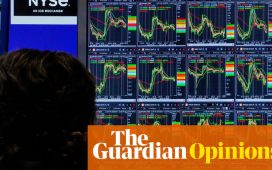Good morning. If the efficient markets hypothesis were true, there would have been no Jim Simons. The founder of Renaissance Technologies died late last week. He was probably the greatest investor ever, measured in terms of how much Renaissance’s main fund beat the stock market, and for how long (other investors, who allowed their funds to grow larger than Simons’ Medallion Fund, generated more total wealth). With people like Simons, it is tempting to think that they had a single brilliant insight into the nature of the market and the economy, which others could not grasp. According to the person who wrote the book about the man, however, Simons’ success was a combination of many things done very well. That is a less romantic picture, but it makes a lot more sense. Email me: robert.armstrong@ft.com.
Upstart versus Lending Club: an anomaly
Upstart and Lending Club do more or less the same thing. They make loans to consumers, retaining some of the loans on their own balance sheets and selling others. But their valuations are miles apart.
The history of fintechs that make consumer loans, a group that includes SoFi and Prosper as well as Upstart and Lending Club, has been rocky. Most companies in the industry started as pure lending “platforms,” that is, some sort of website where people could apply for loans, some sort of underwriting technology to approve and price those loans, and some sort of distribution channel to sell the loans to individuals, institutional investors, or banks. The problem with the platform model is the lack of recurring revenue. When a bank makes a loan and holds it, it receives a stream of interest payments until the loan is paid. The originate-and-sell fintech gets a fee on each loan, and/or a spread between what they paid for the loan and what they sell it for. Then they get nothing until they make another loan.
This is fine, until markets grow turbulent and either the supply of loans or the demand for them, or both, dries up. At that point the fintech’s revenue drops towards zero, and its stock price gets whacked. So many fintechs have decided that retaining some of the loans they make is not such a bad idea.
Last week, Todd Baker, a consultant and banking industry veteran, pointed out a very interesting contrast between two of the companies in a LinkedIn post. It is an “unsolved mystery,” he wrote, that Lending Club originates more loans and has more revenues and profit than Upstart, yet has half the market capitalisation. I pulled together these numbers about the two companies to fill out the picture:

The two companies are not exactly “twins,” which is how Baker puts it. Lending Club has a much larger balance sheet, holding six times as many loans. But Lending Club has only originated about 40 per cent more loans in the past 12 months. And so Upstart’s revenue is much more fee-driven than Lending Club’s. Indeed, over the past year, Upstart’s net interest income, including fair value adjustments, has been negative. Fee revenue, as bank nerds will know, is generally more valuable than net interest revenue, which is capital intensive and risky. So it makes sense, perhaps, that Upstart should have a higher valuation than Lending Club.
But the valuation difference is huge. Not only does Upstart have more than twice the market value, but it trades at 3.6 times book value per share to Lending Club’s .8 times. This seems extreme, especially given the turbulence that has hit fee-driven lenders’ business models in the past.
Lending Club acquired a banking licence through an acquisition in 2020. Maybe the valuation gap is simply a matter of the reward for becoming a bank being valued like a (not especially good) bank. Baker’s post implies that part of the difference is that Upstart, with Google vet Dave Girouard as CEO, has ben treated as an Artificial Intelligence play. The first line of the business description in Upstart’s annual filing: “Upstart is the leading artificial intelligence lending marketplace.” It goes on:
Upstart AI remakes the lending process. We leverage AI to more accurately quantify the true risk of a loan. Our AI models have been continuously upgraded, trained and refined for more than ten years. We apply AI models to income and identity fraud, acquisition targeting, loan stacking, timedelimited default and pre-payment prediction, and servicing. Powered by more than 1,600 variables, our models are trained on more than 58 million repayment events, adding an average of 83,000 new repayments each business day.
This sounds impressive. Baker, however, argued to me that AI-driven underwriting does not make much economic difference in the originate-to-sell side of the business, because loan buyers only look at the FICO scores (credit ratings) of the borrowers. He says the loan buyers don’t like to depend on the originators underwriting technology.
If it is true that the valuation gap is down to Upstart being treat as an AI play, then the fact that the SEC subpoenaed the company in November “seeking various documents and information regarding our disclosures, including the use of our AI models and loans, among other things” may turn out to be important.
How many Americans live “hand to mouth”?
I am not an economist, as regular readers will no doubt have noticed with a sigh. My background and training are in finance. So it is with some trepidation that I will try to explain what a Heterogeneous Agent New Keynesian model is. The key word comes first: a “Hank” model assumes that different households, with different levels of wealth, will adjust their spending and saving differently in response to changes in the economy. In a Hank model, the level of inequality in wealth and income in an economy matters.
Here’s an example, recently discussed by two researchers at the St Louis Fed, Julian Kozlowski and Samuel Jordan-Wood. Suppose the government gives households some money in the form of, say, a stimulus cheque, and pays for those handouts by borrowing. On a standard model, households might save some of the money in anticipation of future tax increases. But a Hank model might ask, how many households have little-to-no liquid savings and high demands on their income? Because these households will not save the extra income, whatever they think might happen to their tax bills in the future. They need to use the money at once.
Kozlowski and Jordan-Wood use US survey data to look at the evolution of the proportion of US households that are, in this sense, living hand-to-mouth. Hand-to-mouth households have insignificant liquid savings relative to their spending needs (note that some of these households might have relatively high outcomes; the definition of hand-to-mouth is only about liquid savings relative to spending). The proportion of households in the US that live hand-to-mouth has fallen from about 30 per cent in 2010 to 19 per cent in 2022. Their chart:

The upshot is that less government stimulus might be spent immediately in the US today, blunting the effectiveness of the stimulus.
There is another possible implication, too. A country with more liquid households, I would think, would change its aggregate spending habits less in response to economic turbulence — including, presumably, high inflation. The resilience of the US consumer, which is most welcome, has been a bit of a mystery. Perhaps it comes down in part to the fact that as much as Americans hate inflation, few of them see it as permanent, and most of them have enough liquid assets to adjust their spending, supporting real consumption growth.
One good read
When the consultants end up running the country.
FT Unhedged podcast

Can’t get enough of Unhedged? Listen to our new podcast, for a 15-minute dive into the latest markets news and financial headlines, twice a week. Catch up on past editions of the newsletter here.









